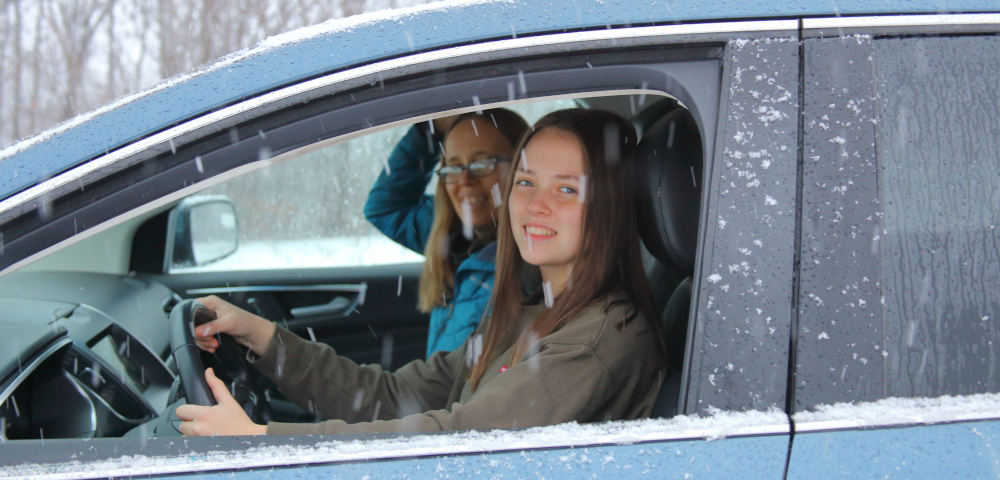Gaining Behind-the-Wheel Experience Navigating ALS

“How am I supposed to drive when I can’t see anything?” my nearly 16-year-old daughter asked.
Sara and I were logging night-driving hours, which are required before she can take the second segment of driver’s education in January. She already has 12 hours behind the wheel, mostly during the day, some while it was raining, and a bit at night.
But winter driving is a much-needed skill in Michigan’s Upper Peninsula, and driving at night with snow coming down adds another level of complexity to the skills I want her to practice.
Visibility was limited on that dark, country road. There were no streetlights, and the houses were set too far back for porch lights to make any difference. A thick layer of lake-effect cloud cover kept the Cold Moon from helping, and the car’s headlights reflected back on falling snow more than they illuminated the road surface, which was covered with snow anyhow, so no lines were visible.
It would not have been easy driving for anyone.

Kristin and her daughter, Sara, drive in the snow this month as part of Sara’s driving lessons. (Courtesy of Kristin Neva)
Driving competency cannot entirely be learned in a classroom or from a book. We can memorize traffic laws, like the shape of a yield sign and that it means we need to let the person with the right of way go first, but competency can only be gained through actual experience behind the wheel. We learn the rules of the road by being on the road, and with enough experience, we execute complex tasks without much thought.
I suppose that is true with any difficult thing in life, that we can prepare to some extent, but we can’t really learn it until we do it.
Gaining experience with ALS
After my husband, Todd, was diagnosed with amyotrophic lateral sclerosis (ALS), I read a lot about the disease. I found online resources and support groups of ALS caregivers. We attended an ALS clinic for a few years, and only stopped because the four-hour trip became too hard to manage with Todd’s increasing disability. I never felt entirely comfortable with anything I learned until Todd was in that situation, and I had repeated hands-on practice with the particular type of care or equipment that was needed.
I felt overwhelmed when I needed to learn to drive Todd’s wheelchair, after he got his feeding tube and I had to flush it and clean the stoma, and especially when Todd’s lungs would fill up or he would aspirate on mucus or food, and I’d have to clear his lungs with the manual assist cough.
During my years working with kids in an after-school program, I’ve been trained on CPR and the Heimlich maneuver in a classroom setting many times, and I even practiced on mannequins, but I never had to do it in real life. But now, over the last few years, I’ve given Todd a seated Heimlich many times, and thus far successfully. It has become so rote, that after his airway is clear, we often carry on our conversation as if nothing happened.
But with ALS, the only thing we can count on is that nothing will stay the same.
I’m feeling overwhelmed again, incompetent even after researching noninvasive ventilation (NIV). Todd has been complaining that he feels like he can’t fully fill his lungs, so he agreed to another pulmonary function test to see if he qualifies for Medicare to pay for a device.
The results were discouraging, and I cried, but he does qualify. And now I’ll need to learn how the machine works. We need to find out if Todd can adjust to the mask. Should he wear a mask that covers his mouth and nose, or will he feel too claustrophobic? Perhaps a nasal mask will work better. How will it affect the quality of Todd’s sleep? Will he sleep more soundly if the machine is helping him breathe? Will it be too difficult to roll him back and forth as he is now used to? Will he need to stay on his back, and will that give him anxiety?
There are a lot of unknowns as of yet, and I won’t have answers until we do it.
And what makes this so difficult is that I can’t see the road ahead, a road that will continue downhill if it follows the decline shown in Todd’s previous pulmonary function tests. He will likely soon have trouble breathing even with NIV.
Navigating ALS is overwhelming, but unlike learning to drive, I can’t gain experience with a coach sitting next to me. I just need to learn to navigate each stage of the disease by doing it myself.
***
Note: ALS News Today is strictly a news and information website about the disease. It does not provide medical advice, diagnosis, or treatment. This content is not intended to be a substitute for professional medical advice, diagnosis, or treatment. Always seek the advice of your physician or other qualified health provider with any questions you may have regarding a medical condition. Never disregard professional medical advice or delay in seeking it because of something you have read on this website. The opinions expressed in this column are not those of ALS News Today or its parent company, Bionews, and are intended to spark discussion about issues pertaining to ALS.








Patty
I can so much relate to your article. Even though I'm just beginning this journey with my husband and his ALS, some days am so completely overwhelmed and feel so helpless. You stated perfectly--how can I maneuver this road if I can't see what is coming.
Thank you...and Merry Christmas
Kristin Neva
Thank you for commenting, Patty! I remember how overwhelmed I was in the beginning too.
Audrey
Your story is heartbreaking , thought provoking , educating & inspiring , the analogy of “ not being able to see the road ahead “ is very profound ! It is so very sad that you & your family are being deprived of so much normality at such a young age , ALS is devastating yet your story is inspiring . My husband has Bulbar ALS , he was diagnosed just two years ago after experiencing a gradual loss of speech , it’s a devastating diagnosis but we are seniors & have experienced many wonderful years together so we are truly grateful for that ! —- ,we continue to find the joy in each day & try to judge how to navigate “ the road ahead “ ! Blessing to you & your family ??
Kristin Neva
Thank you for your kind words Audrey!